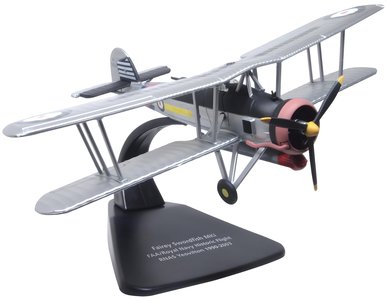The Fairey Swordfish, often simply referred to as the "Stringbag," was a British biplane torpedo bomber used by the Royal Navy during World War II. It was one of the most iconic and versatile aircraft of its era,
The biplane was designed and built by the Fairey Aviation Company in the 1930s and by the time World War II began it was considered outdated, as most other nations had transitioned to faster monoplane designs. However, the Swordfish's ruggedness, simplicity, and slow speed made it suitable for naval operations.
- Crew: Typically, a crew of three: pilot, observer/navigator, and rear gunner.
- Length: Approximately 39 feet (11.9 meters)
- Wingspan: Approximately 45 feet (13.7 meters)
- Maximum Speed: Approximately 138 mph (222 km/h)
- Range: Approximately 546 miles (879 km)
- Armament: Typically carried torpedoes, bombs, or depth charges. It also had a rear-facing machine gun for self-defense.
The Swordfish played a vital role in the early years of World War II, particularly in anti-submarine warfare and naval reconnaissance. Its most famous action was the attack on the German battleship Bismarck in May 1941. Swordfish aircraft from the HMS Ark Royal launched a torpedo attack that severely damaged the Bismarck, leading to its eventual sinking. They were also used in the North Atlantic to protect Allied convoys from German U-boats.
The Fairey Swordfish gained a reputation for its ruggedness and dependability. It became a symbol of the Royal Navy's Fleet Air Arm with its ability to operate from aircraft carriers, even in adverse conditions and remained in service until the end of World War II, after which it was gradually phased out and replaced by more modern aircraft.
The W5856 built by Blackburn Aircraft served with the Mediterranean Fleet for a year and is the oldest surviving flying Fairey Swordfish around. It flew first in 1941, before serving with the Royal Canadian Navy in a training role towards the end of the war. It was restored to flying condition in 1993. A long-term rebuild was completed in 2015, returning the aircraft to an airworthy condition.
The bi-plane is decorated in silver with black, white and yellow markings. Its Royal Navy numbers W5856 and A2A are printed in black and white respectively with A2A featuring again in white on the underside of the upper wings. The many struts, spars and braces, which gave it the wartime nickname ‘Stringbag’ are also painted silver. The upper fuselage and forward section horizontal stabilisers are black, the torpedoes are grey with red nose cone, propeller tips and spinner yellow, engine cowl and exhaust pipes bronze, cockpit interior grey-green and fuselage bands dark red and dark blue. Additional decoration includes a black and white horizontal section on the tail fin, black and yellow wheels and the RAF roundel on both sides of the fuselage.
Oxford Diecast Fairey Swordfish FAA/RN Historic Flight. RNAS Yeovilton - 1:72 Scale, comes in a dispay box with a display stand.
Scale:
1:72
Dimensions: see
this page
Material: mainly metal
Stand: included
Brand: Oxford Aviation

Nr: AC111
In stock:
2
Added to website: 2024-06-03














